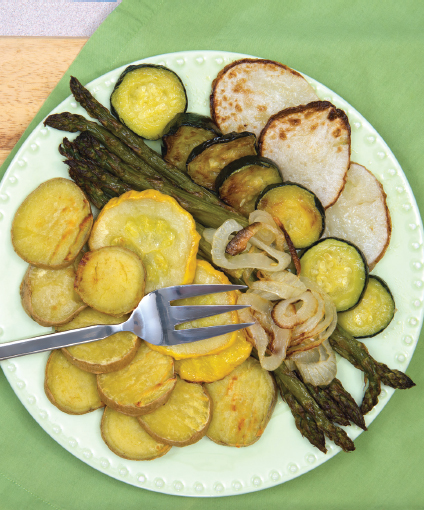![]()
Roasting vegetables condenses their flavor, making them more intense. Leaving the skin on increases the fiber content and adds nutrients. Using a variety of differently colored vegetables provides you with a range of bioflavonoids that help to keep cells healthy. Leftovers are tasty eaten cold, in a salad, or on a sandwich.
![]()
Targeted Side Effects: Fatigue, blood sugar regulation
A good source of vitamin A
Calories: 170; Total Fat: 10 g; Saturated Fat: 1.5 g; Total Carbohydrates: 19 g; Fiber: 4 g; Protein: 3 g
![]()
2 tablespoons olive oil
2 red peppers, cut into ½-inch-wide strips
1 eggplant, cut into ½-inch-thick rounds, skin on
1 sweet potato, cut into ½-inch-thick rounds, skin on
1 yellow onion, cut into ½-inch rounds
2 carrots, cut into ¼-inch rounds
1 green zucchini, cut into ¼-inch rounds
2 parsnips, cut into ½-inch-wide slices
1 yellow squash, cut into ¼-inch-round slices
1 turnip, cut into ½-inch-wide rounds
¼ teaspoon sea salt
Preheat oven to 350°F
1. Cover cookie sheet with parchment paper.
2. With a pastry brush, coat the paper with 1 tablespoon of olive oil.
3. Arrange vegetables in one layer on cookie sheet. Brush with remaining olive oil and sprinkle with sea salt.
4. Roast in the oven, checking frequently to prevent vegetables from burning and to remove cooked, fork-tender vegetables to a covered plate to keep warm while the rest of the vegetables continue to roast.
Health Tip 101: Red peppers are very high in vitamin C, which increases iron absorption, and a good source of vitamin B6 and magnesium, both helpful in decreasing anxiety.

Roasted Vegetables